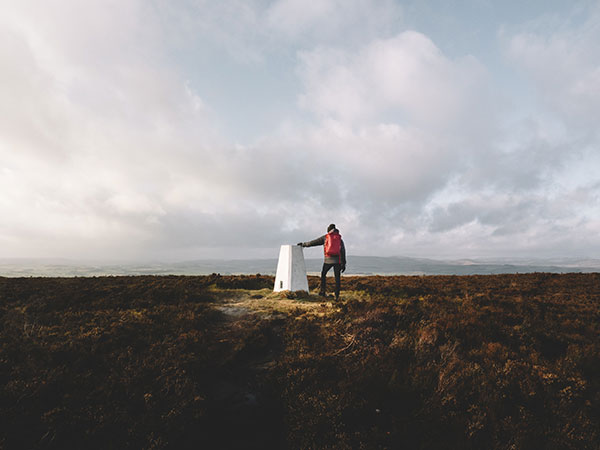Over the last few months, owing to more free time and restrictions on places we’d normally go, Brits have been exploring their own backyard.
Of the new hobbies we’ve adopted over lockdown, generally roaming the outdoors has been the most popular: 18 per cent of Brits took up cycling, 18 per cent wild swimming, 17 per cent hiking, and five per cent kayaking or canoeing.
Unfortunately, laws surrounding the English countryside and waterways aren’t exactly sympathetic to these desires. While in Scotland it’s legal to roam just about anywhere, under trespass laws in England, ordinary people are forbidden to enter 92 per cent of land, and 97 per cent of rivers and lakes. With much of English real estate owned by few, including the gentry, the crown estate, and corporations, this bridle on freedom extends to the land required to produce food, affecting its cost, availability, and sustainability.

My first introduction to the issue of land ownership – and our acquiescence to it – was from the travelling show Three Acres and a Cow (if you get a chance, do go see it). In the space of two hours, it lays out the sheer scale of the land rights issue and how much has been taken from public possession throughout the past thousand years or more.
The most significant change in that time was perhaps that of enclosure, existing in some form since the 13th century. With the aim of increasing agricultural output, enclosure involved transferring plots of land from ‘the Commons’ (natural resources available to everyone) to private ownership. Many could no longer survive on the food they grew themselves alone, thereby necessitating a wage, and creating a class gap where some got incredibly rich while others starved.
The problems arising from enclosure are still felt today. The Land Justice Network, consisting of academics, planners, bird watchers, and architects to name a few, is pretty much founded on the situation caused by enclosure. “Poverty,” reads one of its tenets, “and many of society’s other problems, come from our land not being shared fairly. We want our country to belong to all the people who live there.”

When talking about farming, the main argument against a fair division of the land invariably hinges on maximising production potential. “There has been a whole tendency in policy circles that bigger units are the only way of making it competitive on the basis of economies of scale,” says Dr Matt Reed, an associate professor in food citizenship at the University of Gloucestershire.
Food production volume as a barometer for a farm’s success has its problems, especially in relegating the importance of soil quality, biodiversity, and human health. So how do we convince higher powers that a more benign system of farming can also be efficient?
The Landworkers’ Alliance (LWA) – a union of farmers, foresters, and other growers – may have the answer. Smaller, better managed farms can’t compete on raw yield, but they can outstrip bigger farms when input-to-yield is accounted for. Say an industrial wheat farm produced 8.5 tonnes of wheat per hectare, and an organic wheat farm produced six.

However, the industrial farm sprayed 110kg of nitrogen fertiliser per hectare in order to achieve its harvest, while the organic farm used none. Given the input-to-yield ratio of each farm in this case, and the well-documented effects of excessive nitrogen use on the atmosphere and waterways, which one should we prefer?
The LWA blames the lack of access to land as one of the major barriers for smaller, better-managed farms succeeding. And Reed agrees finding meaningful land to farm on is tough. “But there are things that could be done to open that up, such as local authorities looking at their portfolio of land and making that available to people on a rental or lease basis,” he says.
“Some of the big landowners like the National Trust already play a constructive role with smaller farms – they can play even more of a role in getting people growing. And some of the big private landowners, like the Duchy of Cornwall. And also Mr [James] Dyson.”
Unfortunately, local authorities’ portfolios of agricultural land – known as county farms – are diminishing. Recognised as one of the few ways in helping people afford to get into farming (purchasing farms outright can cost millions), organisations such as CPRE The Countryside Charity are encouraging the protection and promotion of whatever county farms councils have left.

Meanwhile, the LWA suggests improving the “provision of public access farmland through community integration of farms.” Plaw Hatch Farm in Sussex could be one example – though the 500 acres of land it sits on is held as a trust, the business itself is owned by 700 ‘members’ of a co-operative. “This was instrumental in setting the farm up,” explains Nir Halfon, Plaw Hatch’s garden manager. “But it’s the local community that keeps us going, buying the food, and walking around the farm.”
Plaw Hatch uses biodynamic principles, where the vast majority of its inputs are from within the farm, sustaining a circular interaction between soil and plants, and plants and animals. Some 45 varieties of fruit, veg, and herbs are grown on the farm, which also produces meat, cheese, yoghurt, raw milk, wool, honey, oats, and flowers, primarily sold from its on-site shop.
Ultimately, the setup is about providing community access to land. It just so happens the diverse landscape accompanying biodynamic farming also lends itself well to our recently rekindled lust for the outdoors. “You don’t get that desert of rapeseed,” says Halfon. “We want to make it a nice place to walk.”
This article was originally published in the Autumn issue of Wicked Leeks. You can read the full magazine for free on Issuu.












0 Comments